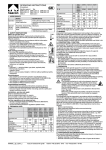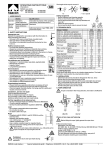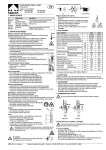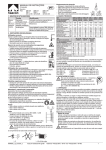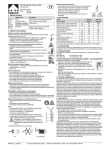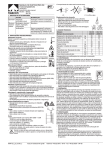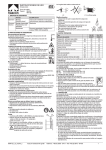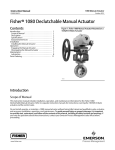Download OPERATING INSTRUCTIONS
Transcript
The length of the rope is correct if: OPERATING INSTRUCTIONS (Translation) Rope winch Type KWE 250 KWE 650 KWE 1000 1. USER GROUPS Duties Operator Operation, visual inspection Special- Assembly, disassembly, ist perrepair, maintenance sonnel Tests GB KWV 300 KWV 650 KWV 1250 Qualifications Instruction by means of the operating instructions; Authorised person 1 Mechanic Authorised person 2 per TRBS-1203 (Technical expert) 2. SAFETY INSTRUCTIONS Appropriate use Operate the equipment in accordance with the information in these operating instructions. –– Only use to lift, lower and pull freely-movable loads. –– Only use when in perfect working order. –– Only allow to be operated by personnel instructed on how to do so. +50° C -20° C > 2 > 1.5 x rope Ø Lifting equipment –– Ensure sufficient load-bearing capacity. –– Only use load hooks with a safety flap. –– Use the approved load hooks with rope thimbles and rope clip. –– Attach the load properly. –– Do not use the winch rope to secure the load. 3. TECHNICAL DATA Type KWE KWV KWE KWV KWE KWV Nominal load [kg] 1st Layer 250 300 650 650 1000 1250 W.L.L [kg] 250 Storage [m] 3,4 300 2,8 650 3,4 650 1000 1250 3,2 3,4 3,2 max. no. of layers Last layer Safety-conscious work –– First read the operating instructions. –– Always be conscious of safety and hazards when working. –– Observe lifting device and load during all movements. –– Immediately report any damage or defects to the person in charge. –– Repair equipment first before continuing work! –– Do not leave the load suspended without supervision. –– Transport device protected against impacts and shocks, falling over or toppling. 6 W.L.L [kg] 125 Storage [m] 22 Rope Ø [mm] 4 FEM Rating1 Breaking load [kN] Crank force [N] 6 6 150 22 340 16 4 7 7 9 9 330 390 490 23 28,5 28,5 6 8 8 1Em 1Em 1Em 1Em 1Em 1Em 7,4 8,9 19,2 19,2 29,5 36,8 220 270 250 240 200 240 Minimum load [kg] 30 30 50 50 50 50 Weight [kg] w.o. rope 3,9 3,9 6,3 5,9 16 16 1) FEM Rating according to DIN 15020 resp. FEM 9.511 for ordinary rope The following are not allowed: –– Overload (--> technical data, type plate, payload plate) –– Mechanical propulsion. –– Impacts, blows. Use exclusions –– Not suitable for permanent operation and vibration stress. –– Not approved for use as builders’ hoist (BGV D7). –– Not approved for use on stages or in studios (BGV C1). –– Not approved for use as a retractable transportation device for personnel (BGR 159). –– Not approved for use in explosive areas/environments. –– Not suitable for aggressive environments. –– Not suitable for lifting hazardous loads. Organisational measures –– Ensure that these operating instructions are always at hand. –– Ensure that only trained personnel work with the equipment . –– Check at regular intervals whether it is being used in a safety and hazard conscious manner. 4. GENERAL The hand winches are drum type winches. They are driven by a single reduction pair of straight cut internal spur gear or direct. The load is safely supported in any position by means of an automatic mechanical brake. 5. MOUNTING –– the mounting structure must be designed to sustain the max forces imposed by the winch –– pay careful attention that the mounting surface is flat and true –– use always 4 screws size M10 (min. quality 8.8 ) –– tighten the screws evenly and secure screws –– ensure that the crank is free running (crank clearance). 6. ROPE MOUNTING With wrong rope coiling the brake is not effective! Installation, service and repair Only by specialist personnel! Only use original spare parts for repairs. Do not modify or alter safety-relevant parts! Additional attachments must not impact safety. Further regulations to be observed are –– German Industrial Health and Safety Ordinance (BetrSichV). –– Country-specific regulations. –– German Accident prevention regulations (BGV D8). ≤3° ≤1,5° ≤3° ≤1,5° Load –– Do not leave suspended without supervision. –– Do not allow to swing. –– Do allow to fall in the rope. Rope –– Compliant with EN 12385-1 and EN 12385-4 and the technical data –– Maintain rope deviation angle non-rotating rope ≤ 3° (standard) rotation-resistant rope ≤ 1.5° –– Use a rotation-resistant rope for unguided loads. This can reduce the resting period of the rope (drive mechanism group). –– Wind up the wire rope under pretension, e.g. fully wind up the rope and adjust the rope length to the lift. 094297_e_gb_hseilw_s 250 - 300 kg 650 kg 1000 - 1250 kg Wire rope fixing Grease slightly the drum, before fixing the wire rope. zz Recommended ropes: Ordinary ropes, zinc plated EN 12385, Tab. 12, 6x19 WC 1770 B sZ (former DIN 3060 SE znk 1770 sZ) Ordinary ropes, stainless steel: similar to EN 12385. 7 x 19 [former DIN 3060 SE bk 1570 sZ (1.4401)] Rope diameter and breaking load see point 3 It is not allowed to use plastic coated ropes. haacon hebetechnik gmbh – Phone +49 (0) 9375 - 84-0 – Fax +49 (0) 9375 - 8466 1 Hard solder the rope end clamp to the rope drum with a hexagonal wrench (SW 4 with 6 Nm, SW 5 with 5 Nm) (fig 1and fig. 2). After rotating the crank in clockwise direction, the rope must reel up on the drum as illustrated in fig. 3. fig. 1 9. MAINTENANCE RECOMMENDATION The operator determines the intervals themselves based on frequency of use and the operating conditions. –– Regular cleaning, no steam jets! –– Carry out visual check on inaccessible brakes / locks every 5 years at the latest, replace brake pads as required. –– General overhaul by the manufacturer after 10 years at the latest. CAUTION! Only perform inspection, maintenance and repair work on an unloaded hoist. Only allow work on brakes and locks to be performed by qualified specialist personnel. fig. 3 fig. 2 A functional test must always be accomplished before beginning work. 7. OPERATION Lift the load: Turn crank clockwise. Lower the load: Turn crank anti-clockwise. If the crank is not turned the load is suspended safely. When lifting a load, do not wind rope beyond the point where at least 1,5 x rope diameter is left free on drum flanges above outermost layer. When loaded, at least 2 turns of the rope must remain on the drum. The capacity of the first layer corresponds to the nominal capacity of the winch. This means that the capacity decreases with every further layer (refer to type-/ capacity number plate for capacity of first and last layer). Version with crank to declutch rope drum (option) Only for unloaded rope. Declutchable rope drum: zz Push crank arm towards the rope winch. The coupling pins move out of the coupling disc. Unloaded rope can be pulled off. Maintenance and inspection work Visual check of the rope hooks (load carrier) Function of the winch Condition of the rope and lifting equipment Brake function under load Grease bearing of drive pinion Check rope for wear acc. to DIN ISO 4309 and service Check fastening bolts for secure seating Check all parts of the winch and crank for wear, if applicable, replace defective parts and lubricate. Check type plate for legibility Have an inspection performed by an expert Intervals Before every use Quarterly Annually Annually Lubricant recommendations: Multi-purpose grease per DIN 51502 K3K-20 Safety crank If sluggishness occurs during lowering, pour a few drops of oil into the gap in the crank cam. Safety cranks with a gap aperture >30° should be replaced. Repair must be carried out by only by the manufacturer. 1- 3 Clutch in: zz Pull and turn crank until the coupling pins engage into the coupling disc. Version with adjustable crank arm (option) zz Loosen wing screw, adjust crank radius, tighten wing screw. 30° max Version with detachable crank(option) CAUTION! Only disassemble the crank, ratchet brace and locking pawl when the equipment is not under load! Do not oil or grease the brake pads! 10. OPERATION FAILURES AND THEIR CAUSES Failure In unloaded state, it is difficult to turn the crank 8. INSPECTION The equipment must be inspected in accordance with the conditions of use and the operating conditions at least once per year by an authorised person 2 per TRBS 1203 (Technical expert) (testing per BetrSichV, §10, sect.2 represents implementation of EC Directives 89/391/EEC and 95/63/EC and the annual occupational safety inspection per BGV D8, §23, sect. 2 and BGG956). These inspections must be documented: –– Before commissioning. –– After significant alterations before recommissioning. –– At least once per year. –– In the event of unusual occurrences arising that could have detrimental effects on the safety of the winch (extraordinary tests, e.g. after a long period of inactivity, accidents, natural events). –– After repair works that could have an influence on the safety of the winch. Technical experts (AP2) are persons, who have sufficient knowledge based on their specialist training and experience, in the areas of winches, lift and pull systems and the relevant official occupational health and safety rules, accident prevention regulations, guidelines and generally accepted engineering rules (e.g. EN standards), to evaluate the operational safety of winches, and lift and pull systems. Technical experts (AP2) are to be nominated by the operator of the equipment. Performance of the annual occupational safety inspection as well as the training required to obtain the aforementioned knowledge and skills can be provided by haacon hebetechnik. 094297_e_gb_hseilw_s Load is not held Cause Lubricant in bearing points is missing. Dirt or something similar has accumulated in the bearing Winch was distorted during mounting. Wrong coiling of the rope winding direction for lifting was not correct. The brake is wornout. Too light load Brake does not Brake discs or release, load may brake mechanism is only be lowered with distorted. high expenditure of force. Elimination Execute maintenance works Check the fixing. Is the mounting surface even, are the screws tightened correctly Lay the rope correctly. Check brake parts and replace worn-out parts. The load has to be at least ca. 20 kg resp. 50 kg Release the brake by slightly striking against the crank arm with the flat of the hand in lowering direction. 11. SPARE PARTS When ordering spare parts it is e s s e n t i a l to quote: –– The type and serial number of the equipment / item and part number 12. DISASSEMBLY, DISPOSAL –– Make sure to observe the safety instructions. –– Dispose of the equipment and the substances within it in an environmentally responsible manner. haacon hebetechnik gmbh – Phone +49 (0) 9375 - 84-0 – Fax +49 (0) 9375 - 8466 2 094297_e_gb_hseilw_s haacon hebetechnik gmbh – Phone +49 (0) 9375 - 84-0 – Fax +49 (0) 9375 - 8466 3 094297_e_gb_hseilw_s haacon hebetechnik gmbh – Phone +49 (0) 9375 - 84-0 – Fax +49 (0) 9375 - 8466 4 094297_e_gb_hseilw_s haacon hebetechnik gmbh – Phone +49 (0) 9375 - 84-0 – Fax +49 (0) 9375 - 8466 5 094297_e_gb_hseilw_s haacon hebetechnik gmbh – Phone +49 (0) 9375 - 84-0 – Fax +49 (0) 9375 - 8466 6






